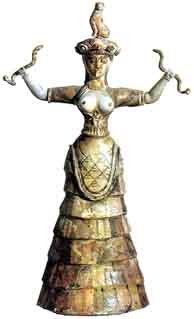Women in the Aegean
Minoan Snake Goddess
Christopher L. C. E. Witcombe
5. The Snake Goddess in Minoan Culture
Part of the attraction of the figurines is that they can be interpreted as embodying many of the perceived, and admired, characteristics of the Minoans: their elegant, fashionable costumes, their physical gracefulness, their sensitive yet forthright personalities, their sophisticated tastes and love of luxury, their refined manners and worldly ways, their seemingly high intelligence combined with an endearing forthright innocence, and their apparent love of beauty, nature, and peace.
Lacking written sources (or at least written sources which provide any real insight into the culture) there is little in the archaeological record to contradict these fondly-held impressions which are derived largely in response to what we see in the physical remains of the Minoans - in statuettes such as the "Snake Goddess", in the frescoes and painted pottery, and in the architecture - and also what we don't see.
Conspicuous in their absence are the usual signs of a male-dominated society common to the Eastern Mediterranean in the second millennium BCE: no walled citadels, no fortifications, no temples to the gods, no large public sculpture, no clear evidence of a hierarchically structured society ruled by kings and priests, no boastful inscriptions.
Possibly when the Minoan script Linear A is deciphered a different view on the Minoan civilization will emerge, but until then the visual evidence alone describes an attractive, easy-going society centered on large labyrinthine palace-like buildings which seem to have served primarily, judging from the huge storage areas, as collection and distribution centers for a well-organized system of local agricultural production, and as the residence of local leaders and, possibly, artists and craftspeople. Who the leaders were is unknown, but circumstantial evidence indicates that women played a dominant role in Minoan religion and perhaps also in Minoan society.
One of the prime pieces of evidence in support of the view that women dominated Minoan culture is the "Snake Goddess." The grounds for this view were laid by Arthur Evans himself. It is clear from the model of Minoan religion constructed by Evans that he was influenced by the theories put forward by James Frazer in The Golden Bough (first published in 1890) that prehistoric religion centred on a dominant goddess of fertility whose young male consort's annual death and rebirth symbolised the decay and regrowth of vegetation.
Evans certainly supported prevailing views about the existence in the prehistoric period [see Earth Mother — Mother Goddess] of a Mother Goddess (identifying as such several Neolithic clay figures found at Knossos) and so, when the "Snake Goddess" came to light in 1903, he not only identified her as a "goddess" but also claimed that she was worshipped by the Minoans as an aspect of the Mother Goddess. Evans thereby provided the basis for the argument that Minoans lived in a matrilineal, or even a matriarchal, society.
6. SNAKE GODDESSES ON CRETE 
|

Minoan Snake Goddess
from Knossos, Crete
c. 1600 BCE
faïence
height 131/2 inches (34.3 cm)
(Archeological Museum, Herakleion)
Copyright © (text only) 2000
Christopher L. C. E. Witcombe
All rights reserved
|

